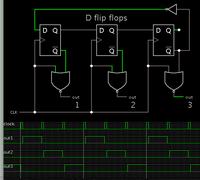boylesg
Advanced Member level 4

- Joined
- Jul 15, 2012
- Messages
- 1,023
- Helped
- 5
- Reputation
- 10
- Reaction score
- 6
- Trophy points
- 1,318
- Location
- Epping, Victoria, Australia
- Activity points
- 11,697
Surely you could setup 3 x 555 based multivibrators and introduce delays between the by passing 2 of the square waves through additional components. But I am having great difficulty in finding out how to do it.
Can anyone point me in the direction of a suitable circuit?
Can anyone point me in the direction of a suitable circuit?


